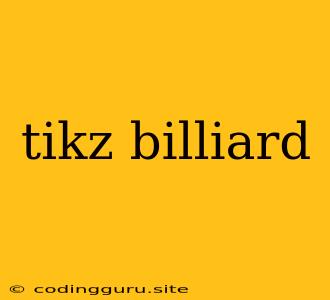Drawing Realistic Billiard Tables with TikZ
Have you ever wanted to create beautiful and realistic diagrams of billiard tables using TikZ? TikZ, a powerful drawing package for LaTeX, offers a flexible and expressive environment for creating complex diagrams. This article will guide you through the steps of drawing a billiard table in TikZ, incorporating realistic details like felt, cushions, and pockets.
Getting Started
To start, you'll need a basic understanding of TikZ syntax. If you're new to TikZ, there are plenty of resources available online to help you get started. Once you have a grasp of the basics, you can move on to creating a billiard table.
Defining the Table Dimensions
First, define the dimensions of your billiard table. Standard billiard tables come in various sizes, but for this example, we'll use a 9-foot table. The standard dimensions for a 9-foot table are approximately 10 feet long and 5 feet wide. We will represent these dimensions using the tikzpicture environment in TikZ.
\documentclass{article}
\usepackage{tikz}
\begin{document}
\begin{tikzpicture}
% Table dimensions
\draw (0,0) rectangle (10,5);
\end{tikzpicture}
\end{document}
This code creates a rectangular shape representing the table's surface.
Adding the Felt
Now, let's add the green felt to the table. You can achieve this using a filled rectangle with a green color. TikZ provides a variety of color options. We will use a standard green color for the felt.
\documentclass{article}
\usepackage{tikz}
\begin{document}
\begin{tikzpicture}
% Table dimensions
\draw (0,0) rectangle (10,5);
% Add green felt
\fill[green!50!black] (0,0) rectangle (10,5);
\end{tikzpicture}
\end{document}
This code fills the rectangular area with a shade of green.
Creating the Cushions
The cushions are the next essential element. We can create these using thick lines that surround the table perimeter. To add depth, we can use a slightly darker color for the bottom side of the cushions.
\documentclass{article}
\usepackage{tikz}
\begin{document}
\begin{tikzpicture}
% Table dimensions
\draw (0,0) rectangle (10,5);
% Add green felt
\fill[green!50!black] (0,0) rectangle (10,5);
% Add cushions
\draw[line width=0.5cm, brown!80!black] (0,0) -- (10,0) -- (10,5) -- (0,5) -- cycle;
\draw[line width=0.5cm, brown!50!black] (0,0) -- (10,0) -- (10,5) -- (0,5) -- cycle;
\end{tikzpicture}
\end{document}
This code draws two sets of lines with different colors and widths to create the cushion effect.
Adding the Pockets
The pockets are the most distinctive feature of a billiard table. We can create them using a combination of arcs and lines. For simplicity, we will focus on the side pockets. Each pocket will consist of two arcs connected by a line.
\documentclass{article}
\usepackage{tikz}
\begin{document}
\begin{tikzpicture}
% Table dimensions
\draw (0,0) rectangle (10,5);
% Add green felt
\fill[green!50!black] (0,0) rectangle (10,5);
% Add cushions
\draw[line width=0.5cm, brown!80!black] (0,0) -- (10,0) -- (10,5) -- (0,5) -- cycle;
\draw[line width=0.5cm, brown!50!black] (0,0) -- (10,0) -- (10,5) -- (0,5) -- cycle;
% Add pockets
\draw[fill=black] (0.5,0) arc (180:0:0.5) -- (1,0) arc (0:180:0.5) -- cycle;
\draw[fill=black] (9.5,0) arc (180:0:0.5) -- (10,0) arc (0:180:0.5) -- cycle;
\draw[fill=black] (0.5,5) arc (180:0:0.5) -- (1,5) arc (0:180:0.5) -- cycle;
\draw[fill=black] (9.5,5) arc (180:0:0.5) -- (10,5) arc (0:180:0.5) -- cycle;
\end{tikzpicture}
\end{document}
This code draws four black filled pockets at the corners of the table.
Adding Additional Details
To create a truly realistic billiard table, you can add further details like:
- Rails: Add thin lines representing the rails along the edges of the cushions for a more accurate representation.
- Numbers: Include the numbers 1-9 on each of the balls for an accurate representation.
- Shadows: Use soft shadows to enhance the three-dimensionality of the table.
Conclusion
By combining basic shapes, colors, and a few more advanced TikZ commands, you can draw realistic and visually appealing billiard tables. The possibilities are endless, and you can further customize your table by adding players, balls, and even the environment surrounding the table.
Remember, with TikZ, you have the power to create intricate diagrams of any subject matter. Experiment with different techniques and explore the vast capabilities of this powerful drawing tool!
